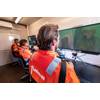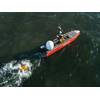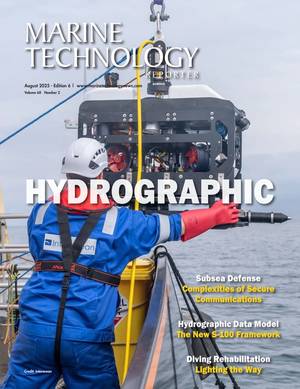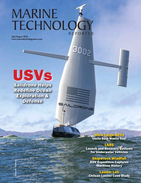Blueye: Making An ROV Autonomous

The Blueye Autonomy project from left to right: Ambjørn Grimsrud Waldum, Leonard Günzel, Gabrielė Kasparavičiūtė, Ai-Nhi Hoang, Jenny Krokstad, Md Shamin Yeasher Yousha, Dana Yerbolat, Abubakar Aliyu Badawi. Missing on the picture: Martin Ludvigsen, Celil Yilmaz, Mahmoud Hussein Abdelrazik Hassan, Elena Marie Kirchman. © Leonard Günzel
Leonard Günzel, a PhD candidate at the Department of Marine Technology at NTNU, is currently leading a new project to make the Blueye ROVs autonomous. The goal of the project is to eliminate the tether connected to the Blueye Surface Unit and enable the ROV to operate independently from a docking station placed on the seafloor.'
Blueye ROVs are connected via a tether to ensure fast, stable, and reliable communication between the drone and the operator. The tether enables real-time data transmission directly to the surface, providing operators with live video and sensor data essential for precise and safe underwater maneuvering. In addition, control signals are sent down to the ROV through the same tether, allowing the operator to continuously adjust direction, speed and camera angle, ensuring full control of the drone at all times.
A tethered system also provides a simple setup, eliminating the need for complex wireless solutions or external base stations. The system is mobile and flexible—it can be used almost everywhere, whether from shore, a boat, or a dock.
The tether also ensures stable power and signal transmission, delivering added reliability in demanding underwater environments.
The tether also serves as a reliable safety measure. If the connection to the ROV is lost, it can always be manually retrieved by pulling it back via the tether.
 Leonard Günzel with the docking station on the research vessel Gunnerus. © Leonard Günzel
Leonard Günzel with the docking station on the research vessel Gunnerus. © Leonard Günzel
Remotely operated vehicles (ROVs), in contrast to autonomous underwater vehicles (AUVs), require a surface-based operator to control the drone. Converting ROVs into AUVs can unlock new possibilities for underwater operations. With autonomy, missions can be carried out without constant human supervision, making the drones more efficient, cost-effective, and capable of operating in challenging environments for extended periods.
Günzel has a background in maritime technology and electrical engineering, but his passion for robotics grew through several research assistant roles and internships at marine institutions around the world. During these periods, he gained experience with applied underwater robotics, image analysis and sensor development.
After several months of simulations and system development, Günzel, together with PhD colleagues Ambjørn Waldum and Gabriele Kasparaviciute and eight master’s students, has now completed their first successful field operation in the Trondheim fjord. The field operation was carried out in collaboration with NTNU’s larger ROV, Minerva, and marks an important technological advancement in autonomous underwater systems. The test demonstrated for the first time that a compact ROV like the Blueye X3 can operate autonomously.
The project team has further developed both the underwater drone and the necessary infrastructure required for long-term autonomous underwater operations. This means the drone must be able to navigate accurately over distances ranging from 100 to 500 meters and return to a docking station placed on the seafloor. This involves the use of a USBL system (Ultra-Short Baseline), which communicates with a modem on the AUV. A USBL system combines multiple transducers to determine the direction and distance to an acoustic source.
In the case of this PhD project, where the goal is to develop autonomous capabilities, direct integration with the drone's control system is essential. Universities, researchers, and system integrators may need to embed the drone into larger systems or control it through third-party software. To support such use cases, Blueye provides an access points for control—the Blueye SDK. This SDK is open source, available on pypi.org, and enables developers and students to build custom control algorithms, automate missions, and explore new applications for underwater robotics.
 Blueye X3 with the custom "Odenwald" frame, multibeam, USBL and extra compute. © Leonard Günzel
Blueye X3 with the custom "Odenwald" frame, multibeam, USBL and extra compute. © Leonard Günzel
The project team hopes this will lay the foundation for future research, ranging from energy-efficient surveys and multi-robot coordination to recurring infrastructure inspections and full mission autonomy. Günzel is particularly excited to further explore situational awareness and perception, and as project manager, he looks forward to the next semester, when the goal is to finally cut the tether for good.
The project is part of the SAFEGUARD initiative and builds on several years of research and development at NTNU. The NTNU VISTA Center for Autonomous Robotics Operations Subsea (CAROS) has played a central role in developing the necessary infrastructure and support systems.













 August 2025
August 2025



